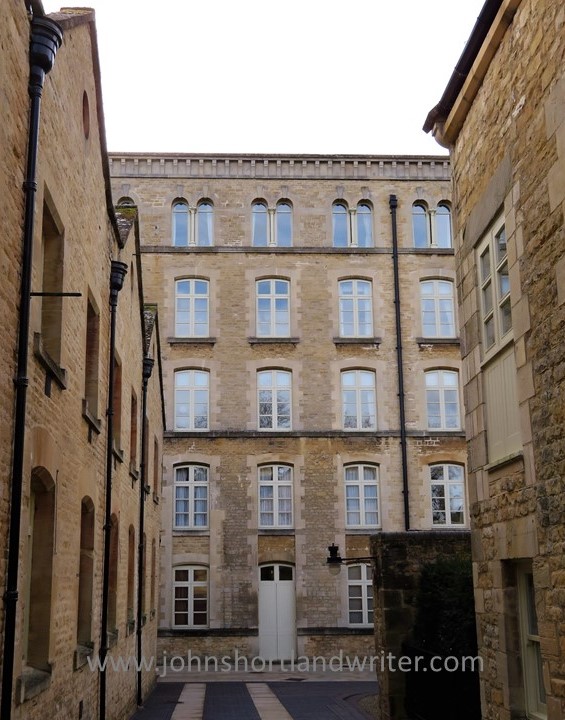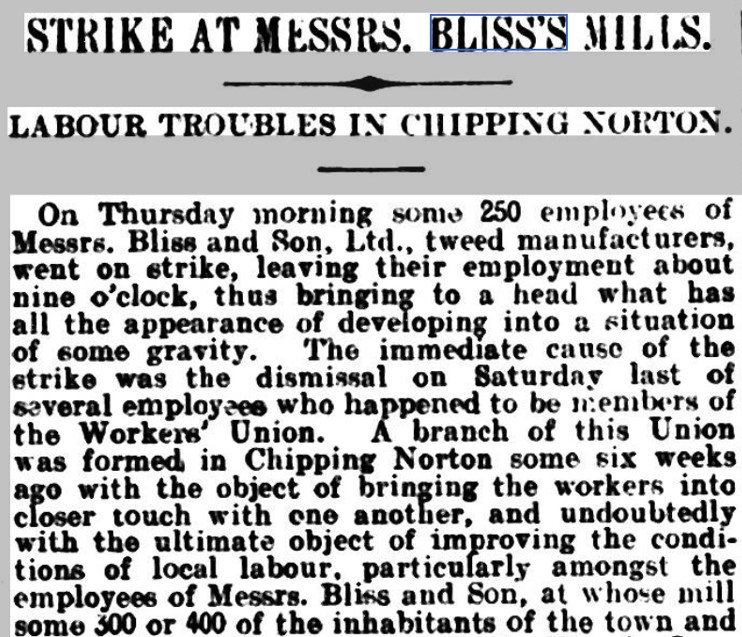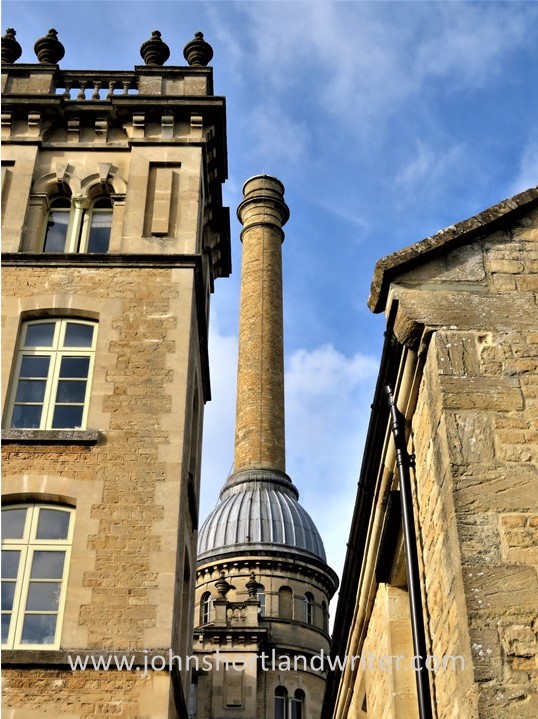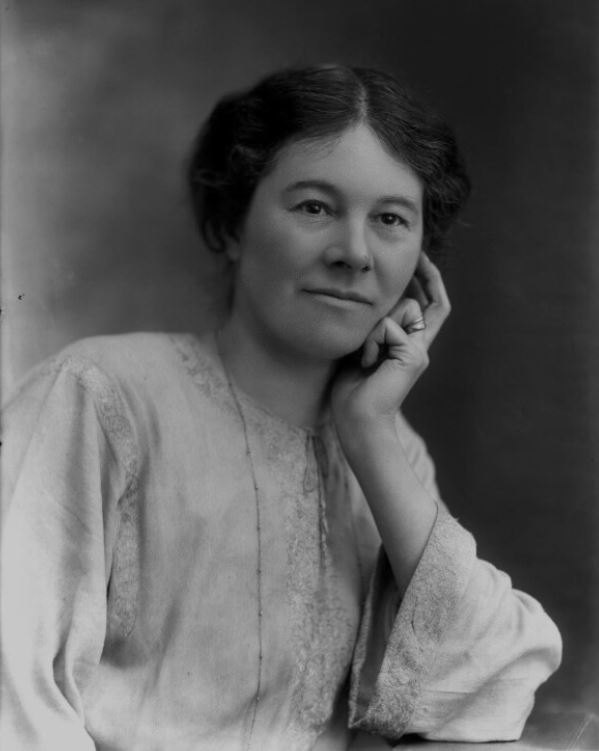Chipping Norton, my local town, is something of an anomaly in the Cotswolds. It’s very much a working town whereas many of the Cotswold centres of commerce rely heavily upon tourism for their trade. Politically, it is a Labour enclave surrounded by the most conservative and Conservative Tory constituencies. Environmentally it differs too – Its common land – wide, green, open public spaces held for posterity – reach deep into the town centre: it is not unusual to see cattle grazing within a few hundred yards of the main shopping streets. The Common also frames Chipping Norton’s most iconic and photographed view, the Bliss Tweed Mill. Seen in its peaceful setting today it is difficult to remember that its history has been quite turbulent.

In the early hours of Wednesday 7th February 1872 fire was discovered on the fourth floor of the mill. By the time the blaze was brought under control the whole building had been destroyed along with the livelihoods of the workforce. The calamity for the town was so great that it was reported in the national press, the Manchester Evening News claiming that the flames were so fierce that “the fire was visible in the [city of] Oxford, a distance of twenty miles from the scene of the catastrophe.” By Friday the press reported that three lives had been lost and three hundred made unemployed. The Bicester Herald gave even more detail: “the fire was discovered by a farm servant around five o’clock in the morning…while a number of men were endeavouring to rescue some books and papers a wall fell, and three of them were killed and several others severely injured.” The article describes how the relatively new, six storey building collapsed and the losses estimated to be £70-100,000, a vast sum in those days. It also reported with restrained understatement that the fire “created the greatest excitement.”

The inquest into the deaths of the three men took place in the town at the Fox and Hounds Inn two days later, on Friday 9th. They were named as Thomas Cook, aged 35 and married, Thomas Peachey, aged 25 and married, and Richard Boscott, a twenty-year-old single man. Although the cause of their death was known the jurors had to ascertain whether they had been instructed to enter the building. It confirmed that they and others had entered an office situated away from the fire to rescue papers when the mill wall collapsed onto the roof of the office and crushing the men who were unaware of the danger. Several witnesses told of their own miraculous escape from the collapse, the noise of which was heard five miles away. One, James Compton, told how his hat was knocked off his head by flying debris but he remained unhurt. It was found that there had been no instruction to enter and as no one person could be held culpable for the fire, the verdict was “accidental death.” The newspapers continued to report daily noting that the first Wednesday market day after the fire, the town was far busier than normal due to the large numbers of visitors, reaching several thousand, walking to the mill to view its smouldering ruins.

Fifteen months later in July 1873, William Bliss, the owner of the tweed mill was able to address his workers and thank them for all their hard work and co-operation over what had been a very challenging time for everyone. The new mill, the present building, was built although wouldn’t be in full production for several more weeks. However, he was able to announce cessation of night work; permission for twenty-four-hour cloth production had been sought and granted by the Factory Inspectorate. He was able to claim that “we may boast of having one of the handsomest and most complete mills in the Kingdom” and, indeed, it was. Out of the ashes had grown a mill building more akin to a country house in appearance.


Designed by the architect George Woodhouse, the main building – the spinning house – was five stories high and faced with local limestone. With its roof surrounded by stone balustrades and the corners of the building topped with stone urns it looked every part the grand residence. Of special pride was the tall chimney built above the circular steam powerhouse. Now a local landmark, it rises as a Tuscan column out of a domed cupola to a height of 165feet (50m). Now a listed (protected) building by HistoricEngland (who aren’t known for their hyperbole), they describe it both as “an exceptional design” and “a remarkable opulent design in a park-like setting.”


The buildings interior was, and still is, equally impressive with its high ceilings and architectural features. Cast iron columns support the vaulted brick ceilings, held with remarkable grace. Even the spiral staircases built into the corners of the building have a balance of style and functionality that is beautiful in its simplicity.

Despite its grandeur and the enthusiasm of the workforce for their new building more trouble arose over the years. By 1889 complaints were being made about the pollution of the millpond both by the growing towns sewage being discharged into the river and the effluent from the mills dye tanks. It was claimed that when the millpond had been emptied the stench was overpowering. Ten years later water issues arose again; this time there being a shortage of water supplying the town’s growing population. As a result, piped water was only available for three hours a day and the mill only able to work two days out of six.

The most disruptive problem for the mill arose when just before Christmas 1913 part of the workforce came out on strike. A local branch of the Workers’ Union had been formed a few weeks earlier and when several men joined, they were promptly fired. The strikers marched through the town where they were addressed by their leader. He advised them on how to conduct themselves: no fighting or bad language, no alcohol, just light-hearted singing and a little banter was all that was needed. As with all strikes, the good humour didn’t last long and there were prosecutions for intimidation of non-striking workers. During the spring of 1914, concerts were being given in the Town Hall and donations requested in aid of the Strike Hardship Fund. Eighteen months after the strike had begun, it ended, broken by the steadfastness of the mill’s management. The 160 now impoverished workers who had remained on strike became officially unemployed and had to seek work elsewhere.


With the advent of World War One later that year, the nation had new concerns. The war, as it happens, also helped the mill recover from the effects of the strike as large orders from the army for khaki cloth were received. Finally, in 1980, the mill closed permanently and a few years later converted into luxury apartments. Although the looms have now been silent for over forty years, Bliss Tweed is remembered as being at the forefront of British woven cloths.


References
British Newspaper Archive: Manchester Evening News, Bicester Herald, Gloucestershire Chronicle, Oxford Weekly News, Oxford Times
Wikipedia
Pinterest: Oxfordshire in 50 Objects

